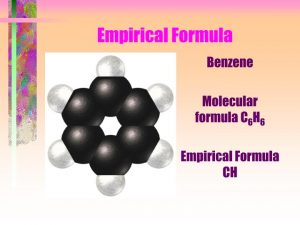Empirical formula in chemistry refers to a smallest integer ratio of the atoms present in a compound. For example, ethane has molecular formula C2H6. The ratio of number of C atoms to the number of H atoms is 2:6. The simplest integer ratio would be 1:3 and, thus, the empirical formula of ethane is CH3. Empirical formula can be deduced from either the mass or the percentage of each element present in a compound.
As an example, let us calculate the empirical formula of a compound containing elements carbon, hydrogen and oxygen. The percentages by mass of C and H in the compound is 66.67% and 11.11% respectively. The relative atomic masses for C = 12, H = 1, O = 16.
First, we notice that we have not been given the percentage of oxygen. However, since the percentage must add up to 100% we can work out the percentage of oxygen as equal to (100.00 – 66.67 – 11.11 = 22.22%).
Now, we work out the number of moles of each element using the formula:
number of moles = mass or percentage/relative atomic mass.
Elements Carbon Hydrogen Oxygen
% by mass 66.66 11.11 22.22
moles 66.66/12 11.11/1 22.22/16
= 5.555 11.11 1.38875
Now, divide by the smallest mole
The simplest ratio 4 8 1
Thus, the empirical formula of the compound is C4H8O.
